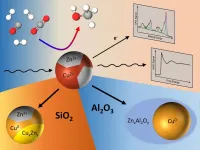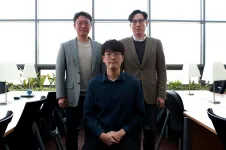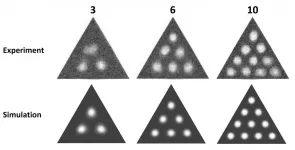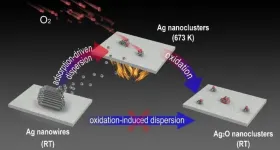SUTD study uncovers how big droughts in the Greater Mekong trigger CO2 emission bursts
Deeper understanding of the climate-water-energy nexus will significantly contribute towards planning and managing transnational power grids.
2021-03-04
(Press-News.org) A study on big droughts in the Greater Mekong region revealed findings that can help reduce the carbon footprint of power systems while providing insights into better designed and more sustainable power plants.
The study, titled 'The Greater Mekong's climate-water-energy nexus: how ENSO-triggered regional droughts affect power supply and CO2 emissions', was published by researchers from the Singapore University of Technology and Design (SUTD) and the University of California, Santa Barbara, in the journal Earth's Future.
Known as an important means to support economic growth in Southeast Asia, the hydropower resources of the Mekong River Basin have been largely exploited by the riparian countries. The researchers found that during prolonged droughts hydropower production reduces drastically, forcing power systems to compensate with fossil fuels -- gas and coal -- thus increasing power production costs and carbon footprint. As such, the vulnerability of hydropower dams to inter-annual changes in water availability hinders their ability to keep to the promise of offering clean energy.
Based on the 2016 energy demand, the researchers estimated that prolonged droughts reduce hydropower production in the Thai-Laotian grid (refer to image) by about 4,000 GWh/year, increasing carbon dioxide emissions by 2.5 million metric tonnes, and increasing costs by US$120 million in one year.
At the same time, power supply was surprisingly found not to be at risk during droughts. This finding suggested that some big coal plants may have a capacity larger than necessary, thus contributing adversely to the environment.
The researchers also found that these phenomena -- droughts and shifts in energy generation mix -- are largely caused by El Nino events. This happens when trade winds weaken, the equatorial Pacific Ocean's surface is warmer than usual and less moisture is delivered to Southeast Asia from the Pacific. The bad news is that anthropogenic climate change may exacerbate El Nino events: if that happens, we will face a drier summer monsoon, with less water available for power systems.
So, what can we do to make power supply more sustainable?
"The answer may lie in mathematical models," explained principal investigator Associate Professor Stefano Galelli from SUTD.
"Our study builds on a new generation of high-resolution water-energy models that explain how each individual power plant reacts to external conditions, such as droughts or increased electricity demand. We can use these models to coordinate water-energy operations across countries, or to prepare contingency plans at the onset of a big drought," he added.
INFORMATION:
[Attachments] See images for this press release:

ELSE PRESS RELEASES FROM THIS DATE:
2021-03-04
The current commercial production of methanol through the hydrogenation of the green-house gas CO2 relies on a catalyst consisting of copper, zinc oxide and aluminum oxide. Even though this catalyst has been used for many decades in the chemical industry, unknowns still remain. A team of researchers from the Interface Science Department of the Fritz-Haber-Institute of the Max Planck Society, the Ruhr-University Bochum, Stanford Linear Accelerator Center (SLAC), FZ Juelich and Brookhaven National Laboratory have now elucidated the origin of intriguing catalytic activity and selectivity trends of complex nanocatalysts ...
2021-03-04
In 2015, hackers infiltrated the corporate network of Ukraine's power grid and injected malicious software, which caused a massive power outage. Such cyberattacks, along with the dangers to society that they represent, could become more common as the number of cyber-physical systems (CPS) increases.
A CPS is any system controlled by a network involving physical elements that tangibly interact with the material world. CPSs are incredibly common in industries, especially those integrating robotics or similar automated machinery to the production line. However, as CPSs make their way into societal infrastructures such as public transport and energy management, it becomes even more important to ...
2021-03-04
A research review led by Oxford Brookes University has found a large proportion of COVID-19 survivors will be affected by neuropsychiatric and cognitive complications.
Psychologists at Oxford Brookes University and a psychiatrist from Oxford Health NHS Foundation Trust, evaluated published research papers in order to understand more about the possible effects of the SARS-COV-2 infection on the brain, and the extent people can expect to experience short and long-term mental health issues.
Patients experienced a range of psychiatric problems
The study found that in the short term, a wide range of neuropsychiatric problems were reported. In one examined study, 95% of clinically ...
2021-03-04
As millions of Fantasy Premier League players mull over a decision whether to start Bruno Fernandes or Mohamed Salah in their teams this weekend, new research by the University of Limerick in Ireland has unlocked the secrets of the popular online game.
A new study by a team of researchers at UL has identified the underlying tactics used by the top-ranked competitors among the seven million players of Fantasy Premier League (FPL), the official - and world's largest - fantasy football game of the English Premier League.
Joseph O'Brien, Professor James Gleeson, and Dr David O'Sullivan, based within the ...
2021-03-04
With three out of four newly emerging infectious human diseases originating in animals*, there is an urgent need to monitor the legal trade in wildlife, according to new research by Vincent Nijman, Professor in Anthropology at Oxford Brookes University.
Professor Nijman, who has been involved in monitoring and regulating the legal wildlife trade for over two decades, said: "Covid-19 more than anything else has put a spotlight on emerging infectious diseases and how this is linked to the trade in wild animals. Few people are aware of its scale. With literally hundreds of millions ...
2021-03-04
New research reveals an essential step in scientists' quest to create targeted, more eco-friendly fungicides that protect food crops.
Scientists have known for decades that biological cells manufacture tiny, round structures called extracellular vesicles. However, their pivotal roles in communication between invading microorganisms and their hosts were recognized only recently.
UC Riverside geneticist Hailing Jin and her team found plants use these vesicles to launch RNA molecules at fungal invaders, suppressing the genes that make the fungi dangerous.
"These vesicles shuttle small RNAs between cells, like tiny Trojan horses with weapons hidden inside," said Jin, a professor of genetics and the Cy Mouradick Chair in the Department of Plant Pathology and Microbiology. ...
2021-03-04
In a close collaboration between experimental and theoretical physicists at Johannes Gutenberg University Mainz (JGU), the research groups of Professor Mathias Kläui and Dr. Peter Virnau investigated the behavior of magnetic whirls within nanoscale geometric structures. In their work published in Advanced Functional Materials, the researchers confined small magnetic whirls, so-called skyrmions, in geometric structures. Skyrmions can be created in thin metal films and have particle-like properties: They exhibit high stability and are repelled from each other and from specially prepared walls. Experiments and accompanying computer simulations showed that the mobility of skyrmions within these geometric structures depends massively on their arrangement. In triangles, ...
2021-03-04
Oxidative dispersion has been widely used in the regeneration of sintered metal catalysts as well as the fabrication of single-atom catalysts.
The consensus on the oxidative dispersion process includes the formation of mobile metal oxide species from large metal particles and the capture of these species on a support surface. Nevertheless, the mechanism of oxidation-induced dispersion has yet to be confirmed via in situ electron microscopic and/or spectroscopic characterizations.
Recently, a research team led by Prof. FU Qiang and Prof. BAO Xinhe from the Dalian Institute of Chemical Physics (DICP) of the Chinese Academy of Sciences (CAS), in collaboration with Prof. YANG Bing from DICP and Prof. GAO Yi ...
2021-03-04
Administering zinc supplements to covid-19 patients with low levels of this element may be a strategy to reduce mortality and recovery time. At the same time, it could help to prevent risk groups, like the elderly, from suffering the worst effects of the disease. These are the findings of a study by physicians and researchers from the Hospital del Mar, Hospital del Mar Medical Research Institute (IMIM) and Pompeu Fabra University (UPF), led by Dr. Robert Güerri, a physician at the Infectious Diseases Service of Hospital del Mar, which has just been published in the journal Nutrients.
The study analysed the zinc levels of 249 adult patients treated at the centre between 9 March and 1 April 2020, with an average age of 65 years. The most common symptoms presented at the time of ...
2021-03-04
Researchers discover how to control zinc content in plants: Could help the world's malnourished
Over 2 billion people worldwide are malnourished due to zinc deficiency. Led by the University of Copenhagen, an international team of researchers has discovered how plants sense zinc and use this knowledge to enhance plant zinc uptake, leading to an increase in seed zinc content by 50 percent. The new knowledge might one day be applied towards the cultivation of more nutritious crops.
A deficiency of zinc and other essential dietary nutrients is one of the greatest causes of malnutrition worldwide. More than two billion people are estimated to suffer from zinc deficiency, a problem that can lead to impaired immune systems, mental disorders and stunting. Among other things, ...
LAST 30 PRESS RELEASES:
[Press-News.org] SUTD study uncovers how big droughts in the Greater Mekong trigger CO2 emission bursts
Deeper understanding of the climate-water-energy nexus will significantly contribute towards planning and managing transnational power grids.






